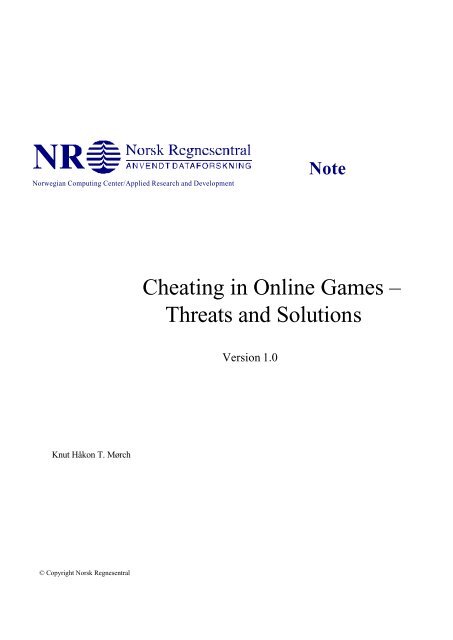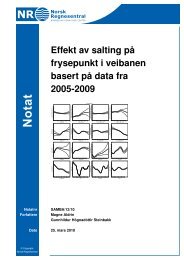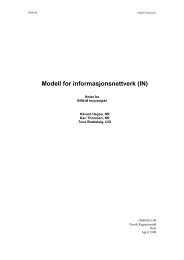Cheating in Online Games.pdf - Index of - Norsk Regnesentral
Cheating in Online Games.pdf - Index of - Norsk Regnesentral
Cheating in Online Games.pdf - Index of - Norsk Regnesentral
You also want an ePaper? Increase the reach of your titles
YUMPU automatically turns print PDFs into web optimized ePapers that Google loves.
Norwegian Comput<strong>in</strong>g Center/Applied Research and Development<br />
Knut Håkon T. Mørch<br />
© Copyright <strong>Norsk</strong> <strong>Regnesentral</strong><br />
Note<br />
<strong>Cheat<strong>in</strong>g</strong> <strong>in</strong> Onl<strong>in</strong>e <strong>Games</strong> –<br />
Threats and Solutions<br />
Version 1.0
Tittel/Title:<br />
<strong>Cheat<strong>in</strong>g</strong> <strong>in</strong> Onl<strong>in</strong>e <strong>Games</strong> – Threats and Solutions<br />
Forfatter/Author:<br />
Knut Håkon Tolleshaug Mørch<br />
1<br />
Dato/Date: January 8 th<br />
År/Year: 2003<br />
ISBN:<br />
Publikasjonsnr.: DART/01/03<br />
Publication no.:<br />
Sammendrag/Abstract:<br />
A survey for a suitable taxonomy and the selection <strong>of</strong> one used <strong>in</strong> this report has been done. Publicly<br />
known cheats for some selected onl<strong>in</strong>e games has been surveyed. Some possible solutions aga<strong>in</strong>st<br />
cheat<strong>in</strong>g have been proposed.<br />
Emneord/Keywords:<br />
Tilgjengelighet/Availability: Open<br />
Prosjektnr./Project no.: 320041<br />
Satsn<strong>in</strong>gsfelt/Research field: Security<br />
Antall sider/No. <strong>of</strong> pages: 17<br />
IT-security, Cheat Detection, Onl<strong>in</strong>e <strong>Games</strong>
Table <strong>of</strong> Contents<br />
INTRODUCTION ............................................................................................................................ 3<br />
1 TAXONOMY............................................................................................................................ 5<br />
2 SOME PUBLICLY KNOWN CHEATS .................................................................................. 7<br />
2.1 CHEATING BY COLLUSION.................................................................................................... 7<br />
2.2 CHEATING BY ABUSING PROCEDURE OR POLICY.................................................................... 7<br />
2.3 CHEATING RELATED WITH VIRTUAL ASSETS ....................................................................... 7<br />
2.4 CHEATING BY COMPROMISING PASSWORDS ........................................................................ 7<br />
2.5 CHEATING BY DENYING SERVICE FROM PEER PLAYERS ......................................................... 7<br />
2.6 CHEATING DUE TO LACK OF SECRECY.................................................................................. 8<br />
2.7 CHEATING DUE TO LACK OF AUTHENTICATION.................................................................... 8<br />
2.8 CHEATING RELATED WITH INTERNAL MISUSE...................................................................... 8<br />
2.9 CHEATING BY SOCIAL ENGINEERING..................................................................................... 8<br />
2.10 CHEATING BY MODIFYING GAME SOFTWARE OR DATA ....................................................... 9<br />
2.10.1 Object Correlation ..................................................................................................... 9<br />
2.10.2 Objects Exposure ..................................................................................................... 10<br />
2.11 CHEATING BY EXPLOITING BUG OR DESIGN FLAW.............................................................. 11<br />
3 CHEATING MITIGATION: PREVENTION, DETECTION AND MANAGEMENT.... 12<br />
3.1 BUILT-IN CHEATING DETECTION........................................................................................ 12<br />
3.2 ENCRYPTION OF SENSITIVE GAME DATA............................................................................ 13<br />
3.3 REDUCE CLIENT’S INFORMATION....................................................................................... 13<br />
3.4 MAKE PLAYERS BE SECURITY AWARE................................................................................ 13<br />
3.5 GOOD PASSWORD PRACTICE AND MANAGEMENT ............................................................. 14<br />
3.6 FAIR TRADING................................................................................................................... 14<br />
3.7 THE BUG PATCHING APPROACH......................................................................................... 14<br />
3.8 AN ACTIVE COMPLAIN-RESPONSE CHANNEL...................................................................... 14<br />
3.9 LOGGING AND AUDIT TRAIL............................................................................................... 14<br />
3.10 POST-DETECTION MECHANISMS........................................................................................ 14<br />
CONCLUSION ............................................................................................................................... 16<br />
REFERENCES................................................................................................................................ 17<br />
2
Introduction<br />
<strong>Cheat<strong>in</strong>g</strong> is an old concept <strong>in</strong> game play<strong>in</strong>g. Card, board games and other none electronic games all have to<br />
deal with the possibility <strong>of</strong> someone not play<strong>in</strong>g by the rules, or cheaters. Some none electronic gametypes<br />
have potential economic revenue for cheaters. One example is the card game poker when us<strong>in</strong>g money to<br />
bet. Others have only the thrill <strong>of</strong> w<strong>in</strong>n<strong>in</strong>g. Electronic onl<strong>in</strong>e games <strong>of</strong>ten have both.<br />
Onl<strong>in</strong>e games, like Warcraft III [6] or Quake III [7], must be purchased <strong>in</strong> order to use them. <strong>Cheat<strong>in</strong>g</strong> to<br />
get someone’s player ID might save some money for the cheater. For some k<strong>in</strong>d <strong>of</strong> games, like the<br />
Massive Multiplayer Onl<strong>in</strong>e Game (MMOG) Anarchy Onl<strong>in</strong>e [5], there is also potential revenue for items<br />
gathered with<strong>in</strong> the game. A search on e-bay [4] for Anarchy Onl<strong>in</strong>e revealed 164 items and/or characters<br />
for sale with start bid rang<strong>in</strong>g from US$ 5 to US$ 800. If cheat<strong>in</strong>g could be used to build powerful<br />
characters or perhaps produce special items, the cheater may actually earn real life money on cheat<strong>in</strong>g <strong>in</strong> a<br />
virtual world. It has also been reported frauds where players have sold but not delivered virtual items and<br />
earned up to US$ 11.000 [10].<br />
Other players just want to be the one with the highest score. This might be accomplished with talent,<br />
tra<strong>in</strong><strong>in</strong>g and/or cheat<strong>in</strong>g. <strong>Cheat<strong>in</strong>g</strong> when play<strong>in</strong>g a real world board game is usually not socially accepted.<br />
When play<strong>in</strong>g an onl<strong>in</strong>e game this changes. Players are <strong>of</strong>ten not on the same physical location and do not<br />
know each other. The social structures prevent<strong>in</strong>g cheat<strong>in</strong>g are no longer <strong>in</strong> place.<br />
From the above it is clear that there are many reasons why one would like to cheat. It is also an important<br />
po<strong>in</strong>t that reasons not to cheat are <strong>of</strong>ten not present. This makes onl<strong>in</strong>e games attractive targets for<br />
cheat<strong>in</strong>g. Although it’s some years old, a survey from 1997 [8] shows that 35% <strong>of</strong> onl<strong>in</strong>e gamers had<br />
cheated. <strong>Cheat<strong>in</strong>g</strong> is clearly noth<strong>in</strong>g only a few players are will<strong>in</strong>g to do. For game developers, cheat<strong>in</strong>g is a<br />
large threat to potential <strong>in</strong>come, as cheaters will make the game less attractive to non-cheaters. A popular<br />
Massive Multiplayer Onl<strong>in</strong>e Role Play<strong>in</strong>g Game such as EverQuest has been reported to reap more than<br />
$50 million a year <strong>in</strong> revenue [21].<br />
Cheats are <strong>in</strong> some ways similar to security holes <strong>in</strong> other s<strong>of</strong>tware. First, only a limited number with<strong>in</strong> a<br />
group knows about the cheat-program or possibility. Then more people with<strong>in</strong> a subgroup get access to<br />
the <strong>in</strong>formation and start us<strong>in</strong>g it. The s<strong>of</strong>tware vendor will usually at some time make a patch and make it<br />
known to everybody that such a vulnerability exists. Unlike the rest <strong>of</strong> the SW <strong>in</strong>dustry the game <strong>in</strong>dustry<br />
has here an advantage. When a patch is made, one can easily force everybody to upgrade <strong>in</strong> order to play<br />
on servers. However, should someone play and not use the patch they will be highly vulnerable. When all<br />
clients/players and/or servers have applied the patch, the risk is reduced to none. This is illustrated <strong>in</strong> the<br />
follow<strong>in</strong>g figure.<br />
3
In the follow<strong>in</strong>g, we will try to present possible methods to cheat <strong>in</strong> onl<strong>in</strong>e games, as well as possible<br />
solutions.<br />
4
1 Taxonomy<br />
In order to discuss cheats and countermeasures, one needs taxonomy to discuss the subject. Some people<br />
have made attempts to establish a taxonomy for cheat<strong>in</strong>g <strong>in</strong> onl<strong>in</strong>e games. Pritchard [1] suggest six different<br />
categories for onl<strong>in</strong>e cheat<strong>in</strong>g:<br />
1. Reflex Augmentation: Exploit<strong>in</strong>g a computer program to replace human reaction to produce<br />
superior results<br />
2. Authoritative Clients: Exploit<strong>in</strong>g compromised clients to send modified commands to the other<br />
honest clients who will bl<strong>in</strong>dly accept them<br />
3. Information Exposure: Exploit<strong>in</strong>g access or visibility to hidden <strong>in</strong>formation by compromis<strong>in</strong>g<br />
client s<strong>of</strong>tware<br />
4. Compromised Servers: Modify<strong>in</strong>g server configurations to get unfair advantages<br />
5. Bugs and Design Loopholes: Exploit<strong>in</strong>g bugs or design flaws <strong>in</strong> game s<strong>of</strong>tware<br />
6. Environmental Weaknesses: Exploit<strong>in</strong>g particular hardware or operat<strong>in</strong>g conditions<br />
This categorization was accord<strong>in</strong>g to Yan and Choi [9] made ad hoc, and many cheats couldn’t fit <strong>in</strong>to<br />
either <strong>of</strong> the categories. Yan and Choi [9] made an improved taxonomy based on Pritchard’s [1]. They<br />
ended up with 11 different categories <strong>of</strong> cheat<strong>in</strong>g for onl<strong>in</strong>e games. We’ve found this to be the most<br />
complete taxonomy published. The taxonomy will be briefly presented below and used <strong>in</strong> our research for<br />
known methods for cheat<strong>in</strong>g <strong>in</strong> onl<strong>in</strong>e games.<br />
1. <strong>Cheat<strong>in</strong>g</strong> by Collusion: It’s not a new th<strong>in</strong>g that players collude to cheat. This might occur <strong>in</strong><br />
games where players are expected to not know what other players know. Consider a game <strong>of</strong><br />
onl<strong>in</strong>e poker. If three players participate <strong>in</strong> a game, two <strong>of</strong> them could cheat the third player by<br />
exchang<strong>in</strong>g <strong>in</strong>formation. Another possibility is one player controll<strong>in</strong>g more than one onl<strong>in</strong>e player<br />
pr<strong>of</strong>ile. In a s<strong>in</strong>gle player game that would enable a player to possibly see areas <strong>of</strong> the virtual world<br />
he could not possible see at the same time with only one onl<strong>in</strong>e player pr<strong>of</strong>ile.<br />
2. <strong>Cheat<strong>in</strong>g</strong> by Abus<strong>in</strong>g Procedure or Policy: In some games statistics is use to record every w<strong>in</strong>s<br />
and losses for a player pr<strong>of</strong>ile. In order to avoid a loss be<strong>in</strong>g recorded, the player might disconnect<br />
before the game ends and the loss is recorded, thus abus<strong>in</strong>g the procedure or policy.<br />
3. <strong>Cheat<strong>in</strong>g</strong> Related with Virtual Assets: Trad<strong>in</strong>g <strong>of</strong> virtual characters and items (e.g. weapons or<br />
magical spells) acquired <strong>in</strong> games is a new and real bus<strong>in</strong>ess created by onl<strong>in</strong>e games. With real<br />
money available cheat<strong>in</strong>g is attractive. With no digital signatures or other techniques to help claim<br />
possession <strong>of</strong> virtual items, cheaters may <strong>of</strong>fer a virtual item, receive real money and not deliver the<br />
virtual item as agreed.<br />
4. <strong>Cheat<strong>in</strong>g</strong> by Compromis<strong>in</strong>g Passwords: A password used by a player is <strong>of</strong>ten the key to all or<br />
much <strong>of</strong> the game data and authorization <strong>in</strong> a game system. Some players are <strong>in</strong>terested <strong>in</strong><br />
compet<strong>in</strong>g for the highest rank. The rank<strong>in</strong>g system is <strong>of</strong>ten only protected by a password. Such<br />
systems might be protected for password guess<strong>in</strong>g by only allow<strong>in</strong>g 3 wrong passwords before<br />
lock<strong>in</strong>g the account. Due to user friendl<strong>in</strong>ess and the possibility <strong>of</strong> Denial <strong>of</strong> Service, such<br />
protection is <strong>of</strong>ten ignored.<br />
5. <strong>Cheat<strong>in</strong>g</strong> by Deny<strong>in</strong>g Service from Peer Players: As discussed above, a system us<strong>in</strong>g<br />
passwords and lock-out protection might be misused to prevent legitimate players from play<strong>in</strong>g,<br />
e.g. <strong>in</strong> a tournament. More experienced players might be blocked this way, thus <strong>in</strong>crease the<br />
cheaters chance <strong>of</strong> w<strong>in</strong>n<strong>in</strong>g. Another common cheat is flood<strong>in</strong>g (or other techniques) one <strong>of</strong> the<br />
other players <strong>in</strong> such a way that the targets responses to the server or other players are significantly<br />
delayed. In real-time strategy games the other players might then vote the slower player out <strong>of</strong> the<br />
game. The cheater could use this to kick more experienced players out <strong>of</strong> the game.<br />
5
6. <strong>Cheat<strong>in</strong>g</strong> due to Lack <strong>of</strong> Secrecy: S<strong>in</strong>ce many onl<strong>in</strong>e games send packets with payload <strong>in</strong><br />
cleartext over the network, a player can easily cheat by eavesdropp<strong>in</strong>g packets or <strong>in</strong>sert<strong>in</strong>g data.<br />
Encryption will possibly solve some <strong>of</strong> these problems.<br />
7. <strong>Cheat<strong>in</strong>g</strong> due to Lack <strong>of</strong> Authentication: Cheats related to lack <strong>of</strong> authentication <strong>of</strong> one or both<br />
part <strong>in</strong> the communication between client and server.<br />
8. <strong>Cheat<strong>in</strong>g</strong> Related with Internal Misuse: System adm<strong>in</strong>istrators for an onl<strong>in</strong>e game server have<br />
the power to do what cheaters want to do. This could <strong>in</strong>clude generation <strong>of</strong> special items that could<br />
be sold to other players for real money, or modify<strong>in</strong>g some character for own use or because some<br />
player paid the system adm<strong>in</strong>istrator.<br />
9. <strong>Cheat<strong>in</strong>g</strong> by Social Eng<strong>in</strong>eer<strong>in</strong>g: Social eng<strong>in</strong>eer<strong>in</strong>g is <strong>of</strong>ten used to steal passwords. There are<br />
many variations <strong>of</strong> this scam but all <strong>of</strong> them aim at the same: to trick players to happily reveal their<br />
ID-password pair. One might try to trick the player <strong>in</strong>to believ<strong>in</strong>g someth<strong>in</strong>g attractive has<br />
happened to the player’s account and that the ID-password pair is needed.<br />
10. <strong>Cheat<strong>in</strong>g</strong> by Modify<strong>in</strong>g Game S<strong>of</strong>tware or Data: This has been a traditional cheat<strong>in</strong>g s<strong>in</strong>ce the<br />
beg<strong>in</strong>n<strong>in</strong>g <strong>of</strong> the PC game area [9], and there are many tools available to enable cheaters to modify<br />
either program file or memory. Cheaters may use debuggers to re-eng<strong>in</strong>eer programs to get some<br />
unfair advantage. Advantages may <strong>in</strong>clude but are not limited to <strong>in</strong>creased speed or other actions<br />
for objects or see<strong>in</strong>g what other players can’t see.<br />
11. <strong>Cheat<strong>in</strong>g</strong> by Exploit<strong>in</strong>g Bug or Design Flaw: Some onl<strong>in</strong>e cheats exploit bugs or design flaws<br />
found <strong>in</strong> a game s<strong>of</strong>tware to get an unfair advantage.<br />
In the rest <strong>of</strong> this report, the taxonomy suggested by Yan and Choi [9] will be used.<br />
6
2 Some Publicly Known Cheats<br />
With the <strong>in</strong>creased popularity <strong>of</strong> onl<strong>in</strong>e games, the number <strong>of</strong> cheats and the players us<strong>in</strong>g them has<br />
<strong>in</strong>creased too. In order to understand the problems a survey has been conducted to f<strong>in</strong>d the cheaters state<strong>of</strong>-the-art<br />
techniques. We do not <strong>in</strong>tend to f<strong>in</strong>d and present all publicly known cheats, but have focused on<br />
f<strong>in</strong>d<strong>in</strong>g cheats for some <strong>of</strong> the most popular onl<strong>in</strong>e games.<br />
Below we present some publicly known cheats with<strong>in</strong> the categories def<strong>in</strong>ed by the taxonomy we chose to<br />
use.<br />
2.1 <strong>Cheat<strong>in</strong>g</strong> by Collusion<br />
There are numerous examples <strong>of</strong> these k<strong>in</strong>ds <strong>of</strong> cheats <strong>in</strong> the real world. In many onl<strong>in</strong>e games there is a<br />
mode <strong>of</strong> play<strong>in</strong>g called ‘Capture The Flag’ (e.g. Unreal Tournament [16]), where two teams compete to<br />
get a flag from the other and br<strong>in</strong>g it to another place. A player on one team will usually be attacked if he<br />
approaches the enemy base. Two players or one player us<strong>in</strong>g two PC’s might ga<strong>in</strong> an advantage for one <strong>of</strong><br />
them by jo<strong>in</strong><strong>in</strong>g one character for both the teams, e.g. blue and red. If the player on the red team tells the<br />
one on the blue team where his red teammates are located the blue team gets an advantage by cheat<strong>in</strong>g.<br />
2.2 <strong>Cheat<strong>in</strong>g</strong> by Abus<strong>in</strong>g Procedure or Policy<br />
In some tournaments, the games are meant to be played as released from the developers. A common cheat<br />
on such occasions is the use <strong>of</strong> scripts or macros. Such a script might decrease the time needed to buy<br />
items on the beg<strong>in</strong>n<strong>in</strong>g <strong>of</strong> a round like the script Nextwish [11].<br />
Another “popular” way <strong>of</strong> cheat<strong>in</strong>g is disconnect<strong>in</strong>g the client to avoid the loss to be recorded. This has<br />
been reported for Warcraft III [14] and Starcraft [9] among others. In Warcraft III the wood and gold<br />
values are locked, thus forc<strong>in</strong>g the game to kick the client without record<strong>in</strong>g the loss. This hack resulted <strong>in</strong><br />
Blizzard delet<strong>in</strong>g all the accounts that had been us<strong>in</strong>g the hack [18].<br />
2.3 <strong>Cheat<strong>in</strong>g</strong> Related with Virtual Assets<br />
It has been reported frauds where players have sold but not delivered virtual items and earned up to US$<br />
11.000 [10]. Especially role-play<strong>in</strong>g games not limited by short “rounds” <strong>of</strong> gameplay are vulnerable to<br />
these k<strong>in</strong>ds <strong>of</strong> cheats.<br />
2.4 <strong>Cheat<strong>in</strong>g</strong> by Compromis<strong>in</strong>g Passwords<br />
Blizzard has a rather strict policy [15] for choos<strong>in</strong>g a password for the account a player create to play<br />
onl<strong>in</strong>e where certa<strong>in</strong> passwords are not allowed, like those found <strong>in</strong> a dictionary. This <strong>in</strong>dicates that steal<strong>in</strong>g<br />
passwords has been a problem.<br />
2.5 <strong>Cheat<strong>in</strong>g</strong> by Deny<strong>in</strong>g Service from Peer Players<br />
7
Where statistics are used there will always be someone who doesn’t want a possible loss aga<strong>in</strong>st a superior<br />
player recorded. One possible method is described <strong>in</strong> 2.2. Another possibility is forc<strong>in</strong>g the other player to<br />
disconnect, thus avoid the loss be<strong>in</strong>g recorded and <strong>in</strong> addition let the other player be recorded as the one<br />
who left before the game was over. In Starcraft a lag hack was used to disconnect the other player [9].<br />
Warcraft III has also been exposed to disconnect cheats [14], where one player forces another player to<br />
get disconnected.<br />
2.6 <strong>Cheat<strong>in</strong>g</strong> due to Lack <strong>of</strong> Secrecy<br />
Networked games without the use <strong>of</strong> cryptography might be vulnerable to <strong>in</strong>spection, modification and<br />
<strong>in</strong>sertion <strong>of</strong> packets sent between players. A computer between two players play<strong>in</strong>g e.g. a first person<br />
shooter game might act as a proxy, <strong>in</strong>spect<strong>in</strong>g packets and <strong>in</strong>sert the right coord<strong>in</strong>ates to make the players’<br />
bullets or similar hit the target.<br />
Aim<strong>in</strong>g proxies has been built for Quake [17]. The first aim<strong>in</strong>g proxies didn’t take <strong>in</strong>to account the player’s<br />
field-<strong>of</strong>-view (FOV), thus shoot<strong>in</strong>g out <strong>of</strong> the back could occur. Later version only aimed at objects with<strong>in</strong><br />
FOV, compensated for lag and added enough randomness to stay below threshold values [1,17]. Other<br />
similar games are also vulnerable to this cheat.<br />
2.7 <strong>Cheat<strong>in</strong>g</strong> due to Lack <strong>of</strong> Authentication<br />
Players normally have to identify themselves <strong>in</strong> order to use onl<strong>in</strong>e servers. Hence, the unique ID is<br />
valuable. A well-known threat to such systems is us<strong>in</strong>g a fake server or mach<strong>in</strong>e-<strong>in</strong>-the-middle-attack,<br />
which <strong>in</strong> some cases could steal or duplicate the unique ID. Worst case is a fake server steal<strong>in</strong>g players<br />
CD-key that proves they bought the game. This CD-key might be resold for real money to other cheaters.<br />
Solv<strong>in</strong>g this problem will <strong>in</strong>clude some k<strong>in</strong>d <strong>of</strong> two-way authentication. A fake server might also use the<br />
auto update feature to <strong>in</strong>stall a backdoor on clients mach<strong>in</strong>e, thus ga<strong>in</strong><strong>in</strong>g full access to all the data on that<br />
mach<strong>in</strong>e.<br />
It is also necessary to re-authenticate users who want to change their password. If not, someone<br />
temporarily leav<strong>in</strong>g their mach<strong>in</strong>e, e.g. <strong>in</strong> an Internet café, could be exposed to someone else chang<strong>in</strong>g their<br />
password.<br />
2.8 <strong>Cheat<strong>in</strong>g</strong> Related with Internal Misuse<br />
Game servers are vulnerable for <strong>in</strong>ternal misuse as they are run by adm<strong>in</strong>istrators who might change the<br />
server’s behavior. It is reported that system adm<strong>in</strong>istrators has been fired [1] due to misuse <strong>of</strong> adm<strong>in</strong>isters<br />
right. A clan might also set up their own server, publish it on the website for the game and use their<br />
adm<strong>in</strong>istrator rights to ga<strong>in</strong> an advantage.<br />
2.9 <strong>Cheat<strong>in</strong>g</strong> by Social Eng<strong>in</strong>eer<strong>in</strong>g<br />
A common scam is pretend<strong>in</strong>g to be some authority person <strong>in</strong> an attempt to get ones CD-key, or the s<strong>in</strong>gle<br />
th<strong>in</strong>g that uniquely dist<strong>in</strong>guish that a player actually bought a copy <strong>of</strong> the game. Blizzard [20] has published<br />
8 rules to avoid such scams, <strong>in</strong>dicat<strong>in</strong>g this k<strong>in</strong>d <strong>of</strong> cheat<strong>in</strong>g is widely used and known.<br />
8
2.10 <strong>Cheat<strong>in</strong>g</strong> by Modify<strong>in</strong>g Game S<strong>of</strong>tware or Data<br />
There are many ways to modify game s<strong>of</strong>tware or data. Many games have a game eng<strong>in</strong>e with different<br />
modifications (Mods). These games can communicate <strong>in</strong>ternally between the game eng<strong>in</strong>e and the Mod,<br />
and that communication might be <strong>in</strong>tercepted and values changed [13].<br />
Such values might be found like reported <strong>in</strong> [1], where a player paused the game and searched for known<br />
values seen on the paused screen, i.e. the stock <strong>of</strong> wood and stones. Another approach for f<strong>in</strong>d<strong>in</strong>g where<br />
to hook <strong>in</strong>to the game or modify exe-files is look<strong>in</strong>g at the s<strong>in</strong>gle-player cheats many vendors provide [1].<br />
Some cheat might change values to <strong>in</strong>crease target<strong>in</strong>g or fir<strong>in</strong>g rate, like <strong>in</strong> Battlefield 1942 where cheaters<br />
could get 50% less <strong>of</strong>f target for bullets and double fir<strong>in</strong>g rate [2]. There are two subcategories <strong>of</strong> this k<strong>in</strong>d<br />
<strong>of</strong> cheat<strong>in</strong>g that are very common and well documented: object correlation and object exposure. Because<br />
<strong>of</strong> the popularity <strong>of</strong> these cheats they will be expla<strong>in</strong>ed more detailed below.<br />
2.10.1 Object Correlation<br />
Cheats related to object correlation is cheats that try to correlate e.g. a bullet and the target. Such<br />
correlation might be done by provid<strong>in</strong>g the user with <strong>in</strong>formation to visually or automatically better correlate<br />
two objects.<br />
Extrasensory Perception (ESP)<br />
ESP cheats try to provide the player with visual enhancements to better enable the player to correlate<br />
between two objects. One such ESP cheat is improved or new radar and map for a game. Many games<br />
run a full copy <strong>of</strong> the game on each client, i.e. the client knows where all the other objects are. When the<br />
objects are positioned a place the player is meant to see them, they are shown on the screen. A<br />
modification might add a m<strong>in</strong>imap or similar on the screen show<strong>in</strong>g where all the other objects are at any<br />
time, like it’s done for Counter Strike and Warcraft III [17,14].<br />
Some games have built-<strong>in</strong> features allow<strong>in</strong>g players to choose easy to spot colors for the enemies. This is<br />
not considered cheat<strong>in</strong>g. However, some cheats might remove textures, like it has been done for Quake III<br />
by modify<strong>in</strong>g CVAR values [12]. This will give the cheater a better possibility to spot the enemies although<br />
this feature was not <strong>in</strong>tended from the game developers.<br />
Another variant <strong>of</strong> ESP is “glow” [17]. Glow ESP helps a player see enemies better. Either the whole<br />
object is changed to a color that is light or “glow<strong>in</strong>g”, or only the sides <strong>of</strong> the objects are “glow<strong>in</strong>g”. This<br />
makes it easer to dist<strong>in</strong>guish friend from foe or spot objects <strong>in</strong> dark areas.<br />
In some first player shoot<strong>in</strong>g games a crosshair or aim<strong>in</strong>g object is used target the object to shoot. This<br />
object might be improved or <strong>in</strong> some cases where such an object is not already present be <strong>in</strong>serted to help<br />
the player aim. Sometimes the aim is only a dot, and an improved aim<strong>in</strong>g object could significantly <strong>in</strong>crease<br />
the chance <strong>of</strong> hitt<strong>in</strong>g the target.<br />
Automatically aim<br />
9
As described above, some games use a game eng<strong>in</strong>e and a MOD with <strong>in</strong>ternal communication. It is<br />
possible to hook <strong>in</strong>to such solutions and modify the data to e.g. always hit the head <strong>of</strong> nearby enemies, like<br />
one aim hack for Counter Strike [17]. Such cheats correlates the attack object (e.g. a bullet) with the most<br />
vulnerable spot on the target.<br />
Another automatically aim cheats changed the color <strong>of</strong> all the enemies <strong>in</strong> Counter Strike [17] to one color.<br />
The mouse po<strong>in</strong>ter was then changed to automatically move to that color, mak<strong>in</strong>g it easier to aim. The<br />
drawback with this technique is that the mouse po<strong>in</strong>ter would move to any part <strong>of</strong> the body. Before cheat<br />
detection for this hack was issued, other players tried to beat the cheaters by spray<strong>in</strong>g similar colors on the<br />
walls, a feature possible <strong>in</strong> Counter Strike [17]. Some advanced automatically aim<strong>in</strong>g cheats has the<br />
possibility to only activate the gathered data (e.g. for a head shot) when the player press a certa<strong>in</strong> button,<br />
mak<strong>in</strong>g it easier to avoid be<strong>in</strong>g spotted as a cheater.<br />
2.10.2 Objects Exposure<br />
The goal for these cheats is to show someth<strong>in</strong>g to the player that he shouldn’t be able to see. This can be<br />
done be remov<strong>in</strong>g objects or mak<strong>in</strong>g it possible to see objects meant to be hidden beh<strong>in</strong>d other objects.<br />
Removed objects<br />
In some games certa<strong>in</strong> groups <strong>of</strong> objects clouds the visibility <strong>of</strong> other objects – and they are meant to. In<br />
Counter Strike smoke grenades release clouds <strong>of</strong> smoke that are very opaque, mak<strong>in</strong>g them hard to see<br />
through. Cheats remove these clouds [17]. Warcraft III uses someth<strong>in</strong>g called fog <strong>of</strong> war. This is visible as<br />
a layer over the terra<strong>in</strong> that only lets the player view the contour <strong>of</strong> the landscape below. Some cheats<br />
remove this, giv<strong>in</strong>g the player the opportunity to explore the whole map without mov<strong>in</strong>g objects around to<br />
remove the fog <strong>of</strong> war [14].<br />
Transparent objects<br />
This k<strong>in</strong>d <strong>of</strong> cheat is <strong>of</strong>ten known as wall hack [17]. The follow<strong>in</strong>g group <strong>of</strong> cheats are also known as wall<br />
hack, but this is probably the one most players th<strong>in</strong>k <strong>of</strong> when a wall hack is mentioned, i.e. the ability to see<br />
through walls. Sometimes these cheats makes all walls <strong>in</strong> a map 50% transparent [17]. In other words, it is<br />
possible to make some group <strong>of</strong> objects more or less transparent, mak<strong>in</strong>g objects beh<strong>in</strong>d them visible.<br />
Changed object layers<br />
This method aims at show<strong>in</strong>g objects a player wants to see without modify<strong>in</strong>g objects like walls. A cheater<br />
can put some objects that are located beh<strong>in</strong>d others <strong>in</strong> front <strong>of</strong> those hid<strong>in</strong>g them, mak<strong>in</strong>g them visible. A<br />
solution might be to put all objects <strong>of</strong> a certa<strong>in</strong> k<strong>in</strong>d <strong>in</strong> front <strong>of</strong> any other object. This might – like <strong>in</strong> Counter<br />
Strike [17] – be a player model, enabl<strong>in</strong>g a player to know where other players are located. This wall hack<br />
is more efficient than ‘transparent objects’ because the cheater now only sees what is important and not<br />
everyth<strong>in</strong>g else beh<strong>in</strong>d the wall. See<strong>in</strong>g everyth<strong>in</strong>g can limit ones ability to navigate on the map.<br />
Textual <strong>in</strong>formation<br />
Text can be shown about an object to reveal details about it not visually easy to spot for humans [17]. This<br />
might be items a player is carry<strong>in</strong>g or the players’ health or strength. It is possible to make the text visible<br />
on top <strong>of</strong> other objects, e.g. a player model. Further it’s possible to show the text on top <strong>of</strong> other objects,<br />
10
<strong>in</strong> effect creat<strong>in</strong>g a wall hack with only the text visible through walls. This has the effect that the player<br />
models are located where they should, but the cheater will get an early warn<strong>in</strong>g when text is shown on a<br />
wall but no player model is visible, i.e. the player model is beh<strong>in</strong>d the wall.<br />
2.11 <strong>Cheat<strong>in</strong>g</strong> by Exploit<strong>in</strong>g Bug or Design Flaw<br />
Onl<strong>in</strong>e games have thousands <strong>of</strong> l<strong>in</strong>es <strong>of</strong> code. Errors are likely to happen. Some recent bugs are the<br />
human farm bug <strong>in</strong> Warcraft III and cancel request bug <strong>in</strong> Ages <strong>of</strong> Empire. The first bug allows “a human<br />
player to build a farm <strong>in</strong> a very small clear<strong>in</strong>g <strong>of</strong> trees, and cont<strong>in</strong>ually build and cancel it. For unknown<br />
reasons, the player ga<strong>in</strong>s the cost <strong>of</strong> build<strong>in</strong>g a farm, without the orig<strong>in</strong>al cost be<strong>in</strong>g deducted. Essentially,<br />
this bug can generate endless amounts <strong>of</strong> resources for a human player” [14].<br />
The bug <strong>in</strong> Ages <strong>of</strong> Empire used the fact that when the network was lagg<strong>in</strong>g, it was possible to issue several<br />
cancel requests for a build<strong>in</strong>g <strong>of</strong> a build<strong>in</strong>g. When the network worked aga<strong>in</strong> – or was no longer attacked<br />
by the cheater – all the cancel requests for the same build<strong>in</strong>g would be processed, return<strong>in</strong>g more resources<br />
than <strong>in</strong>itially spent when start<strong>in</strong>g the build<strong>in</strong>g [1].<br />
11
3 <strong>Cheat<strong>in</strong>g</strong> Mitigation: Prevention, Detection and Management<br />
Well-known security mechanisms such as cryptographic protocols have many applications <strong>in</strong> onl<strong>in</strong>e games.<br />
However, beat<strong>in</strong>g the cheaters has no s<strong>in</strong>gle solutions. A process-oriented approach is required for the<br />
best possible solution. Yan and Choi [9] treated the subject ‘<strong>Cheat<strong>in</strong>g</strong> Mitigation’ <strong>in</strong> their paper. Here,<br />
we’ve used theirs group<strong>in</strong>g <strong>of</strong> possible solutions and extended them with others.<br />
3.1 Built-<strong>in</strong> <strong>Cheat<strong>in</strong>g</strong> Detection<br />
The battle between cheaters <strong>in</strong> onl<strong>in</strong>e games and the anti-cheaters are quite similar to the virus battle.<br />
However, with cheats <strong>in</strong> onl<strong>in</strong>e games the anti-cheaters have an advantage: the possibility to build cheat<strong>in</strong>g<br />
detection <strong>in</strong>to the games from the beg<strong>in</strong>n<strong>in</strong>g. Many game developers, such as Joe Wilcox from Epic <strong>Games</strong><br />
[27], supports such an approach and are work<strong>in</strong>g on implementation <strong>in</strong> onl<strong>in</strong>e games.<br />
Yan and Choi [9] argues that “<strong>in</strong> case game providers cannot guarantee good security for game client<br />
s<strong>of</strong>tware, the built-<strong>in</strong> detection should be implemented <strong>in</strong> a game server, which is typically <strong>in</strong>stalled <strong>in</strong> a<br />
protected environment where it is difficult for cheaters to tamper the s<strong>of</strong>tware”.<br />
Such built-<strong>in</strong> cheat detection for the server s<strong>of</strong>tware might be reused, thus it’s a cost-effective alternative.<br />
Cheat detection could be related to such parameters as suddenly <strong>in</strong>crease <strong>in</strong> hits for a player <strong>in</strong> a shooter<br />
game, or detection <strong>of</strong> actions that lead to duplication <strong>of</strong> items.<br />
The United Adm<strong>in</strong>s s<strong>of</strong>tware HLGuard [26] relies heavily on sett<strong>in</strong>g threshold levels for hit rates with<strong>in</strong><br />
some time w<strong>in</strong>dow to detect automatically aim<strong>in</strong>g or correlation between objects, i.e. statistical analysis.<br />
The method <strong>of</strong> statistically identify players whose aim is too good to be true is also recommended by<br />
Pritchard [1]. This has the effect that some players claim that they are banned just because they are good<br />
players [25]. This might be true, and illustrates a pitfall us<strong>in</strong>g such techniques.<br />
However, as we have seen from chapter 3, quite a lot <strong>of</strong> the known and used cheats today are based on<br />
modification <strong>of</strong> the client s<strong>of</strong>tware. Techniques to reduce such possibilities would hit the cheaters harder.<br />
One such technique used by several game servers us<strong>in</strong>g is demand<strong>in</strong>g the <strong>in</strong>stallation <strong>of</strong> s<strong>of</strong>tware for and<br />
right to scan client mach<strong>in</strong>es <strong>in</strong> an attempt to f<strong>in</strong>d known cheats or altered CRC for game files. Such<br />
solutions could easily be built <strong>in</strong>to a game. However, <strong>in</strong>vad<strong>in</strong>g players’ privacy, e.g. look<strong>in</strong>g at other files<br />
than those related to the game itself, is controversial. Sony attempted this approach with their popular<br />
onl<strong>in</strong>e game EverQuest. The result was a massive negative response from the player community, with the<br />
result that Sony backed away from the proposed solution, and didn’t search for s<strong>of</strong>tware on client<br />
mach<strong>in</strong>es [24].<br />
Pritchard [1] argues that all clients might and for many onl<strong>in</strong>e games already do run a full copy <strong>of</strong> the game<br />
simulation. This enables cheaters to f<strong>in</strong>d <strong>in</strong>formation about the other players, but it might be used aga<strong>in</strong>st<br />
them. A cheat detection system might answer questions like “Can a player see the object he just clicked<br />
on?” [1]. The system might do this by randomly request<strong>in</strong>g a report <strong>of</strong> the game simulation copy on the<br />
clients, thus f<strong>in</strong>d<strong>in</strong>g those tampered with and that are out <strong>of</strong> synch.<br />
Such system might discover a mach<strong>in</strong>e between a server and a client modify<strong>in</strong>g data. If the data received at<br />
the server is not compliant with those on the client, someth<strong>in</strong>g weird is go<strong>in</strong>g on. Another application is for<br />
12
peer-to-peer networks where authoritative clients might fool others to bl<strong>in</strong>dly accept commands or data<br />
from them. By mov<strong>in</strong>g from issu<strong>in</strong>g commands to issu<strong>in</strong>g requests, one can look for <strong>in</strong>valid request that<br />
should not have been sent. Another cheat detection mechanism is us<strong>in</strong>g what is proposed above, runn<strong>in</strong>g a<br />
full copy <strong>of</strong> the game simulation on all clients and send<strong>in</strong>g out a request as a status check to f<strong>in</strong>d cheaters<br />
with conflict<strong>in</strong>g CRC or similar [1].<br />
3.2 Encryption <strong>of</strong> Sensitive Game Data<br />
Cheaters <strong>of</strong>ten f<strong>in</strong>d their targets easy prey because data can bee seen <strong>in</strong> clear text, either between the client<br />
and server or <strong>in</strong>ternally <strong>in</strong> the mach<strong>in</strong>e under the cheaters control. An approach to reduce this threat is<br />
encrypt<strong>in</strong>g important data kept <strong>in</strong> memory or sent between the client and server or between the game<br />
eng<strong>in</strong>e and a modification (Mod).<br />
There are many encryption schemes useful for onl<strong>in</strong>e games, like the Advanced Encryption Algorithm [28].<br />
However, such cryptographic algorithms might be to resource consum<strong>in</strong>g. Another solution that might be<br />
sufficient is us<strong>in</strong>g XOR for important values. That would make it more difficult to e.g. search for known<br />
values <strong>in</strong> memory e.g. for a paused game. Each new patch for a game could <strong>in</strong>clude a new XOR key to<br />
make a cheaters life more difficult.<br />
Pritchard [1] suggest another k<strong>in</strong>d <strong>of</strong> “encryption”, known as security through obscurity. By dynamically<br />
chang<strong>in</strong>g the command syntax, hackers will have more trouble f<strong>in</strong>d<strong>in</strong>g the desired data <strong>in</strong> memory. Such<br />
solutions are not popular <strong>in</strong> the academic world, but from a practical approach, everyth<strong>in</strong>g that <strong>in</strong>crease the<br />
pa<strong>in</strong> <strong>of</strong> the attacker at a low cost for the defender has some clear advantages.<br />
3.3 Reduce Client’s Information<br />
Some games run a full game simulation locally, enabl<strong>in</strong>g cheaters to f<strong>in</strong>d <strong>in</strong>formation they were not<br />
supposed to see, like for Counter-Strike [19]. For that game, United Adm<strong>in</strong>s has created a protection<br />
called HLGuard [26]. The anti-cheat program has features aga<strong>in</strong>st the wall hack: it removes objects the<br />
client cannot possibly see on a certa<strong>in</strong> map. Thus, it stops a cheater from receiv<strong>in</strong>g <strong>in</strong>formation about other<br />
liv<strong>in</strong>g players that player was not meant to see.<br />
Similar techniques to reduce the client’s <strong>in</strong>formation about other objects <strong>in</strong> a game could be implemented<br />
from the beg<strong>in</strong>n<strong>in</strong>g <strong>of</strong> a games lifecycle. The downside is the heavier load on the server to make such<br />
decisions.<br />
3.4 Make Players be Security Aware<br />
Many cheats could have been avoided if the players were more security aware. Many cheats <strong>in</strong>clude some<br />
k<strong>in</strong>d <strong>of</strong> social eng<strong>in</strong>eer<strong>in</strong>g, like the scams mentioned by Blizzard [15,20], e.g. to get ones unique ID that<br />
prove a player bought the game. Game providers need to educate their customers about potential threats<br />
and ways to behave, much like banks have done to learn their customers about security related to the use<br />
<strong>of</strong> e.g. VISA card. Players must known what k<strong>in</strong>d <strong>of</strong> scams or cheats to look out for and be provided with<br />
possible solutions, like whom to contact if they believe they lost their unique game ID. Such education may<br />
take long time, and must be a cont<strong>in</strong>u<strong>in</strong>g process.<br />
13
3.5 Good Password Practice and Management<br />
Passwords are a commonly used security technique to restrict access to e.g. a players account on a server.<br />
However, us<strong>in</strong>g easy to guess passwords makes such an account easy prey for a cheater. Some users<br />
might even choose a password vulnerable to a dictionary attack. Due to usability issues such a th<strong>in</strong>k as<br />
lock<strong>in</strong>g out an account with three wrong password guesses are <strong>of</strong>ten not implemented and dictionary<br />
attacks are then possible. A proactive password checker is needed to not allow weak passwords. Such a<br />
checker might deny all passwords found <strong>in</strong> a dictionary. It’s also necessary to educate the players and<br />
guide them when choos<strong>in</strong>g a password, like Blizzard has done [15].<br />
3.6 Fair Trad<strong>in</strong>g<br />
Trad<strong>in</strong>g with virtual items is a little bus<strong>in</strong>ess itself. A researcher estimated that Norrath, a virtual world<br />
owned by Sony as part <strong>of</strong> their game EverQuest, is the 77 th richest country <strong>in</strong> the world [23]. Some<br />
companies do not want such trad<strong>in</strong>g to occur. But if such activity is accepted, it should also be supported.<br />
A common cheat or scam is to advertise someth<strong>in</strong>g <strong>in</strong> a virtual world, collect the payment and not give<br />
away any virtual items. Hav<strong>in</strong>g the game provider act<strong>in</strong>g as a trusted third party could assure the buyers to<br />
actually get the virtual items they bought.<br />
3.7 The Bug Patch<strong>in</strong>g Approach<br />
“No developer can fix all bugs before s<strong>of</strong>tware release. The traditional bug patch<strong>in</strong>g approach <strong>in</strong> security<br />
still works here” [1].<br />
3.8 An Active Compla<strong>in</strong>-response Channel<br />
A compla<strong>in</strong> channel is necessary to enable players to report new bugs, cheats and possible cheaters. Game<br />
providers must provide fast responses to ensure players will cont<strong>in</strong>ue to use the channel and believe they’re<br />
taken seriously.<br />
3.9 Logg<strong>in</strong>g and Audit Trail<br />
Logg<strong>in</strong>g and audit trail is necessary to f<strong>in</strong>d certa<strong>in</strong> cheats, <strong>in</strong> particular evidence <strong>of</strong> new cheats. This is also<br />
necessary to deal with the <strong>in</strong>sider threat. Logg<strong>in</strong>g and audit trails ensure that the game providers have a<br />
better chance <strong>of</strong> prov<strong>in</strong>g someone is cheat<strong>in</strong>g.<br />
3.10Post-detection Mechanisms<br />
In order to beat the cheaters, some k<strong>in</strong>d <strong>of</strong> discipl<strong>in</strong>ary punishment is needed. If cheat<strong>in</strong>g doesn’t result <strong>in</strong><br />
anyth<strong>in</strong>g negative for the cheater, they will likely cont<strong>in</strong>ue cheat<strong>in</strong>g. One such punishment is disabl<strong>in</strong>g the<br />
14
user account associated with the cheat. At the same time, those <strong>of</strong>fended by the cheat should have some<br />
possibility <strong>of</strong> restor<strong>in</strong>g e.g. someth<strong>in</strong>g that was taken from them.<br />
15
Conclusion<br />
<strong>Cheat<strong>in</strong>g</strong> <strong>in</strong> onl<strong>in</strong>e game is a serious problem with potentially large economic losses for the game <strong>in</strong>dustry.<br />
Those cheat<strong>in</strong>g expose themselves to malicious s<strong>of</strong>tware, e.g. Trojans [22]. It’s clear that implement<strong>in</strong>g<br />
measures to mitigate cheat<strong>in</strong>g is necessary. Such measures must be seen as a process, start<strong>in</strong>g with the<br />
design <strong>of</strong> the architecture.<br />
16
References<br />
1. Matt Pritchard, How to Hurt the Hackers: The Scoop on the Internet <strong>Cheat<strong>in</strong>g</strong> and How You<br />
Can Combat It, Available: http://www.gamasutra.com/features/20000724/pritchard_01.htm, July<br />
24 2000, Accessed 12-16-2002,<br />
2. Palad<strong>in</strong> X, Battlefield 1942 Cheats & Hacks, Available: http://www.counterhack.net/content.php?page=bf1942,<br />
Accessed 12-12-2002<br />
3. Battlefield 1942 North American 1.2 Patch, Available:<br />
http://www.ea.com/eagames/<strong>of</strong>ficial/battlefield1942/editorial/bf1942_12patch.jsp, Accessed<br />
16.12.2002<br />
4. E-bay, www.ebay.com, Accessed 12-17-2002<br />
5. Anarchy Onl<strong>in</strong>e, www.anarchyonl<strong>in</strong>e.com, Accessed 12-16-2002<br />
6. Warcraft, www.warcraft.com, Accessed 12-16-2002<br />
7. Quake III Arena, www.ids<strong>of</strong>tware.com/games/quake/quake3-arena, Accessed 12-16-2002<br />
8. Greenhill, R., Diablo, and Onl<strong>in</strong>e Multiplayer Game’s Future,<br />
Available:http://www.gamesdoma<strong>in</strong>.com/gdreview/depart/jun97/diablo.html, Accessed 12-17-<br />
2002<br />
9. Yan, J. J. & Choi, H. J, Security Issues <strong>in</strong> Onl<strong>in</strong>e <strong>Games</strong>, The Electronic Library: <strong>in</strong>ternational<br />
journal for the application <strong>of</strong> technology <strong>in</strong> <strong>in</strong>formation environments, Vol. 20 No.2, 2002,<br />
Emerald, UK, Available: http://www.cl.cam.ac.uk/~jy212/TEL.<strong>pdf</strong>, Accessed 01-02- 2002<br />
10. Hankyoreh, Onl<strong>in</strong>e <strong>Cheat<strong>in</strong>g</strong> is ubiquitous, Available: http://www.hani.co.kr/section-<br />
005100025/2001/05/005100025200105091907004.html, Accessed 12-17-2002<br />
11. Nextwish, www.nextwish.org, Accessed 12-16-2002<br />
12. Cheats & Hacks: Quake III www.counter-hack.net/content.php?page=quake3, Accessed 01-<br />
02-2003<br />
13. Why <strong>Cheat<strong>in</strong>g</strong>-Death is Different, Available: www.cheat<strong>in</strong>g-death.com/cddiff.htm, Accessed 01-<br />
12-2002<br />
14. Cheats & Hacks: Warcraft 3, Available: www.counter-hack.net/content.php?page=warcraft3,<br />
Accessed 01-02-2003<br />
15. Blizzard Support, Battle.net Account Password Security,<br />
http://www.blizzard.com/support/?id=asi0505p, Accessed 01-02-2003<br />
16. Unreal Tournament, www.unreal.com, Accessed 12-16-2002<br />
17. Cheats & Hacks: Half-Life & Mods, Available: www.counterhack.net/content.php?page=halflife,<br />
Accessed 01-03-2003<br />
18. Counter Hack: Game Specific News: Warcraft III, Available: http://www.counterhack.net/<strong>in</strong>dex.php?game=warcraft3,<br />
Accessed 01-03-2003<br />
19. Counter-Strike, www.counter-strike.net, Accessed 01-07-2003<br />
20. Blizzard support, Simple rules to follow on protect<strong>in</strong>g your CD-Key, Available:<br />
http://www.blizzard.com/support/?id=asi0635p, Accessed 01-03-2003<br />
21. Carter, M., Hack<strong>in</strong>g <strong>of</strong> Web game EverQuest L<strong>in</strong>ked to local teen, 08-31-2001, Available:<br />
http://seattletimes.nwsource.com/html/localnews/134335724_hacker31m.html, Accessed 01-07-<br />
2003<br />
22. Paris, W. S., RE: Increase <strong>in</strong> Sub7 scans, 06-12-2001, Available:<br />
http://onl<strong>in</strong>e.securityfocus.com/archive/75/190653, Accessed 01-07-2003<br />
23. Dodson, S., Lord <strong>of</strong> the r<strong>in</strong>g, 03-21-2002, Available:<br />
http://www.guardian.co.uk/computergames/story/0,11500,670972,00.html, Accessed 01-07-<br />
2003<br />
24. Borland, J., Onl<strong>in</strong>e game backs away from privacy threat, 04-05-2000, Available:<br />
http://news.com.com/2100-1017-238900.html, Accessed 01-07-2003<br />
17
25. rq60, HLGuard aimbot detector, May 2002, Available:<br />
http://forums.unitedadm<strong>in</strong>s.com/showthread.php?s=&threadid=19661, Accessed 01-07-2003<br />
26. United Adm<strong>in</strong>s HLGuard, Available: http://www.unitedadm<strong>in</strong>s.com/HLGuard.aspx, Accessed<br />
01-07-2003<br />
27. Unreal Playground, Exclusive Interview with Dr. S<strong>in</strong> <strong>of</strong> Epic <strong>Games</strong>, 10-03-2002, Available:<br />
http://www.unrealplayground.com/<strong>in</strong>terview.php?id=1, Accessed 12-17-2002<br />
28. FIPS-197 Advanced Encryption Standard, Available: http://csrc.nist.gov/encryption/aes/,<br />
Accessed 01-07-2003<br />
18











